After sharing a photo of Jane’s sourdough on Instagram I asked if there would be any interest in seeing some tips and tricks for making sourdough bread. I don’t do recipes, and if you follow me it is not because of my amazing baking skills. BUT, my wife does have amazing baking skills. In fact, I’ve been pushing her to start her own bakery for years (luckily she hasn’t listened or we’d likely be living on the streets in this current economic/pandemic economy). The response was overwhelming. You all want sourdough recipes. So I’ve managed to coerce Dashing Mom into giving some tips and tricks for making sourdough and rounding it off with a recipe. Without further adieu here it goes:
Hi everyone! The whole world has extra time on their hands these days and wants to learn to make sourdough. Sounds good to me! I love baking bread and am happy to encourage the rest of the world to join in. There is something so satisfying about baking bread from scratch.
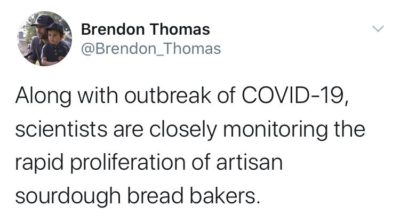
Making sourdough is SO EASY. I’ve been baking bread for years and honestly, it’s the easiest type of bread I’ve ever made. There is no kneading, no precise timing, no fancy ingredients (unless you feel like it!). Most of the time Clara helps me and if she could read the numbers on our scale and safely operate an oven she could probably do it herself. It’s a bit hard to know where to start with these tips and tricks because there are whole corners of the internet and many many books dedicated to this subject, but here goes nothing. These are a few things I’ve learned along the way that help me.
First – what is sourdough? Sometimes I feel like the internet thinks sourdough is only one thing – a round crusty loaf, or boule. But it’s really wild or live yeast culture that you bake with. Most commercially available bread is made using dried yeast. Which is tasty and delicious (I still bake with that kind of yeast all the time!), but yields a very different bread than sourdough yeast. What this means is sourdough bread can be anything. Crusty loaves, soft fluffy sandwich bread, crispy almost deep-fried focaccia (recipe for this below – it’s my favorite!), chewy buns, bagels, breadsticks, sweet rolls, savory loaves, and even waffles! So, depending on what you want to make, you would need a variety of different equipment, but you definitely don’t need it all. In fact, the recipe I’m sharing today uses the most basic of kitchen supplies (oven, cookie sheet, bowl, and measuring cups or a scale). I’m hoping to show you that this is EASY and you don’t need fancy stuff.
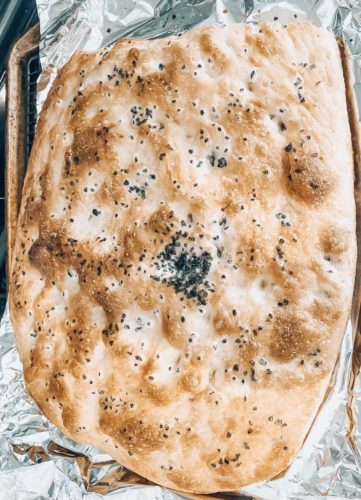
Stuff you need (plus some long-winded explanations about why you may or may not actually need these things):
A sourdough starter. Except if you want to get all technical about it, you don’t even need a sourdough starter. You can make (or again – technically – catch) your own, using just flour and water. Now, I’ve never had any success with making my own starter (I’ve tried a few times), but if you want to give it a whirl, here is a link to a tutorial: King Arthur Flour. You can also buy a starter online. My mom did this and had great success. Here is where she got hers from: Cultures for Health. Or you can get it from a friend. A friend like ME!
If you live locally, I’m happy to share my starter with you! Just get in touch and we will figure out a way to meet up, keep 6 ft apart, and hand over a container filled with wild yeast. (You can also DM Matt on Instagram)
A scale or measuring cups. Now, I know I said you don’t need anything fancy, but if I could encourage you to buy only one thing to help you make sourdough it would be a scale. It helps SO MUCH. You can, of course, use measuring cups, but a scale is faster, more efficient, more precise and helps to ensure you can consistently get good results. A scale is what ensures I get a good loaf when my toddler is haphazardly scooping flour into the bowl and missing half the time. Here is a link to a good scale, but there are lots out there and you can easily get them for under $20.
A baking sheet/loaf pans/cake pan/dutch oven. I personally use all these things, but it depends on what kind of bread you want to bake. A baking sheet is what is needed for the recipe below. If you want to bake sandwich bread, then loaf pans are what you need, a 9×13 cake pan is perfect for buns and a dutch oven is what you need if you want a crusty sourdough boule. (Though here are some hacks if you want to make a boule and you don’t have a dutch oven)
- A bowl big enough for your ingredients and room for the dough to rise
- Recipe ingredients. This is self-explanatory I hope.
- Bread Knife. How else are you going to get into your loaf? Tear it with your hands like a heathen?
Then depending on your recipe or what you are making you may need one, some or none of these things:
- Proofing banneton (Only needed for a boule! A bowl works too!)
- Parchment Paper (if you are baking in a dutch oven – again if you’re making a boule)
- Lame or sharp knife (to make fancy patterns in your fancy loaf of bread – again for a boule)
- Bench Scraper (to clean your counters, cut dough into smaller pieces, help move dough around, etc.)
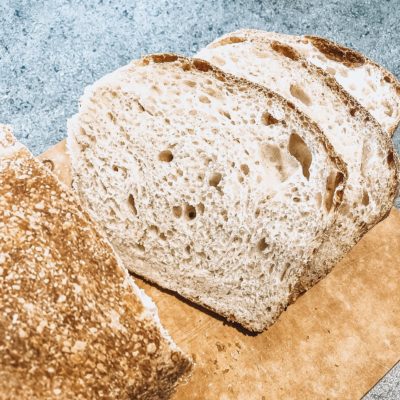
Caring for your sourdough starter
Now you have a starter, and all the right tools, what happens next? This is, in my opinion, the hardest part or making sourdough – and it’s not even that hard. You just need to remember that having a sourdough starter is a little bit like having a pet. Since it is a live yeast culture you need to feed and water it regularly. Sometimes also take it for walks…. kidding. Kinda. So how often do you need to feed it? Well, it depends. If you are using it, keep it on the counter and feed and water daily. If you need a break from all the delicious bread your making, then shove in the back of the fridge and feed it once a week, or even let it go dormant (aka ignore it for long periods of time) and feed it less often. I’ve left mine in the back of my fridge for months (when I had Ryker and couldn’t manage to feed myself let alone a wild yeast culture lol), and it still happily churns out bread when I want it to. Here is the basic ‘recipe’ for feeding a starter.
To feed your starter combine 1 part water, 1 part flour, and 1 part starter, by weight. I typically do about 60 grams of each. That gives me enough starter to make 2 loaves of bread, then feed my starter to get it ready for the next round of baking. If you haven’t gotten a scale yet, that’s about 1/2 cup flour, 1/4 cup water, and 1/3 cup starter. Discard your excess starter, OR find a good recipe to use up your ‘discard starter’. Waffles are always a popular choice!
*About Hooch – if your starter gets a greyish liquid on top, that’s fine. You can pour it off or stir it back in, either is a good choice.
*About walking your starter – so this is a bit of a joke, but also a bit of a real thing. Some people take their starters out into the world (to breweries is popular!) to ‘catch’ different yeast strains. Totally optional, but kinda fun!
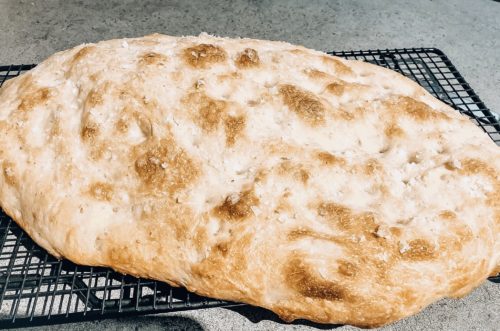
Using your starter
Now we’re getting into the meat – so to speak – of the tips and tricks for making sourdough bread. When you want to bake bread, aim to use your starter at peak bubbly-ness. If your starter has been on the counter and you’ve been feeding it regularly, feed it in the morning and then you can mix up your dough that night. If your starter has been in the fridge, you will want to pull it out of the fridge and feed it once or twice before you use it in a recipe.
Ok, I’ve been typing a lot.
I swear this is actually easy. Way easier to make the bread than it is to type it all out. Once you make the focaccia bread below once or twice I swear you will also think it’s easy. The recipe below is the easiest recipe with the biggest payoff. The timelines on it are totally flexible. It has the most basic ingredients. There is no kneading. It is a showstopper of a recipe that is best eaten hot and straight out of the oven. You can change up the toppings and flavours. You can serve it with almost anything (on its own, with soup, stew, lasagna, make it into croutons, sandwiches, dip it in fondue, balsamic, herbed oil, top it with pizza toppings, garlic, herbs, ham and swiss before baking it… the options are endless). I’ve served this as an appetizer at a few dinner parties and unfortunately (or maybe fortunately?) my guests have been so full of focaccia that no one actually has any room for dinner by the time I put it on the table.
Hopefully, these tips and tricks for making sourdough bread have been helpful and I hope you love this recipe as much as I do!
[penci_recipe]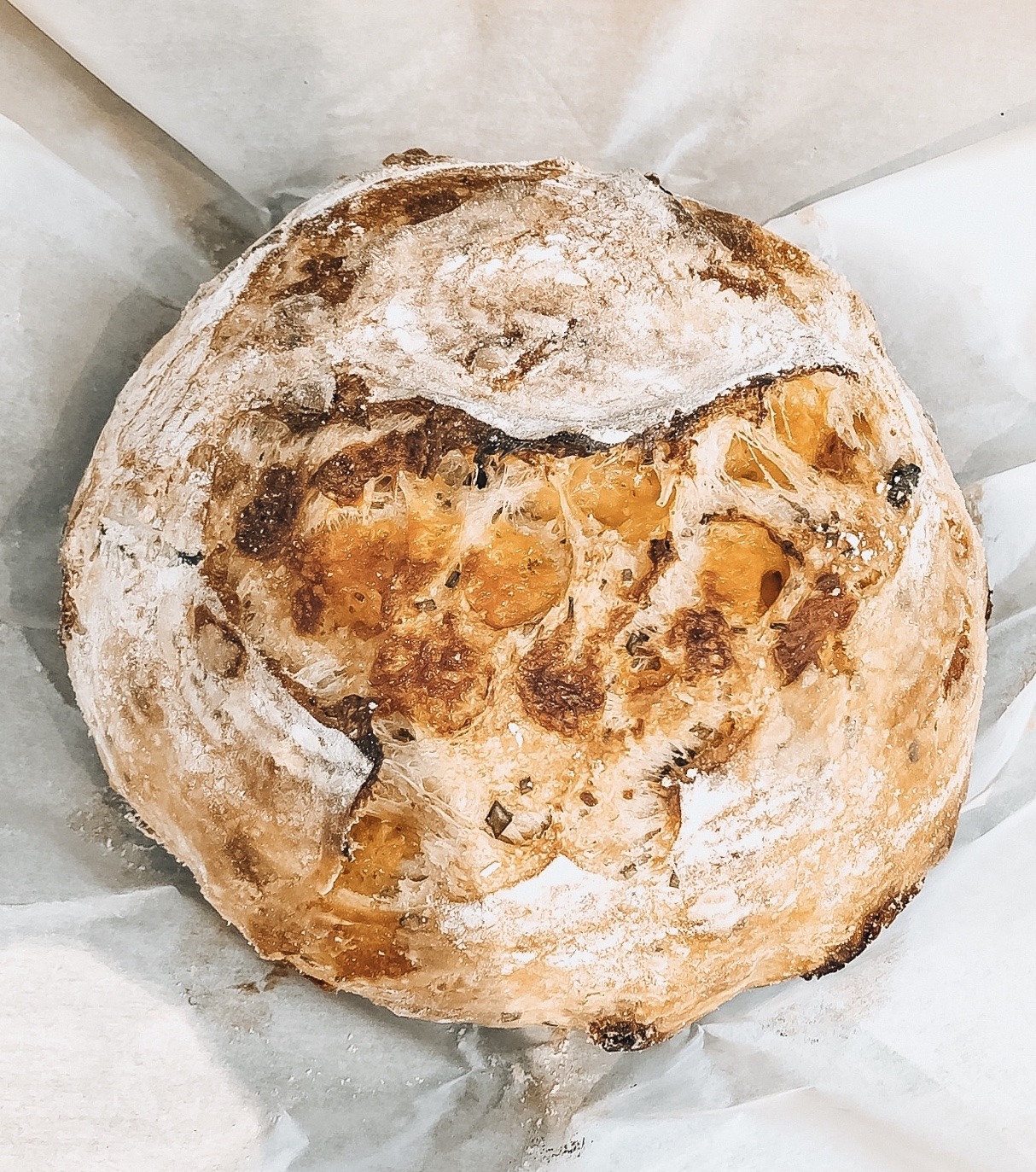
Leave a Reply